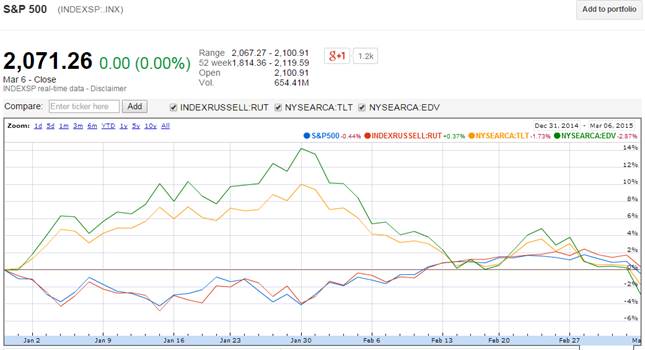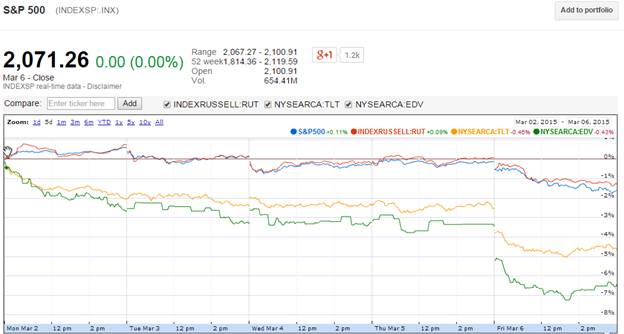Last week was a rough week for investors, especially those that were invested in US Treasury Bonds. It has been an especially volatile year so far for US Treasury Bonds. To recap: They surged into year-end 2014 and then continued to push ahead steadily throughout the month of January. Stocks, on the other hand, struggled throughout January only to initially recover and move into positive territory year-to-date during February. For stock investors, the strength in the February jobs report was enough reassurance that the economy was doing well, so they started buying stocks.
Interestingly, though, the equally strong March jobs report caused those same stock investors to become concerned that the Federal Reserve will raise interest rates as early as June. So they turned around and sold stocks, causing the major stock market averages to decline sharply. As a result, the S&P 500 Index is once again down for the year at -0.44% (through Friday’s close). The Russell 2000 is barely positive at +0.37 whereas the Nasdaq is up +2.73% powered ahead mainly by the likes of Apple and Google. Here’s a look at the major equity indexes vs select US Treasury Bonds ETFs.
Stocks vs US Treasury Bonds ETFs Performance Chart YTD (through March 6)
US Treasury Bonds have been the big losers since the end of January. They sold off significantly in early February after the February jobs report and started to recover the 3rd week of February. But then concerns over the March jobs report caused the decline in US Treasury Bonds to resume. The rout last week was relentless and only got worse when the Friday jobs report came out. The stock market averages like the S&P 500 were down around two and a half percent for the week, but the 20 and 30 year US Treasury bond ETFs (TLT and EDV) were down 4.5 to 6.5%. That is painful to any type of investor. But time horizons can add perspective. For the year, the iShares Barclays 20+ Yr Treasury Bond (TLT) is down -1.73% and the Vanguard Extended Duration Bond (EDV) is now down 2.87%. Here’s a 5 day chart from last week:
So where do investors go from here?
It depends on whether or not you believe (like the ‘bulls’) that even though the economy remains weak that stocks are the only game in town and that investors dissatisfied with earning 0% interest in their savings will continue to shift their money into higher risk stocks.
Or do you believe the bear case that thinks that we are experiencing a global slowdown and that it is and will continue to impact the US economy? If you believe the bull case more strongly then you should sell US Treasury bonds if you own them and push that money into stock markets that are at or near all-time highs. Of course, you also better be comfortable having your cost basis near the highest market levels ever in the over 100 year history of the stock market.
I believe it is possible for some sectors of the market to continue to move higher—especially those in healthcare, consumer discretionary and technology. But those are sectors that will also do well for those that believe in the bear case. Personally, I believe that there is a higher probability that the bear case will play out over the coming weeks and months.
The only reason for bond yields to continue to go up (and the value of bonds to go down) is because the economy is starting to accelerate. I believe that the data shows that this is not the case. Last week China cut interest rates on businesses because their economy is weakening. Japan’s GDP was just revised down significantly from the 2.2% reading in February to 1.5%. Germany’s exports just posted their biggest drop in 5 months. Europe is desperate to counter the threat of deflation and has launched another quantitative easing program.
In order for these other countries to spur growth, they are taking actions to devalue their currencies relative to the USD. That means a stronger dollar and results in importing deflation to America. Here are some statistics that support this hypothesis:
Year-to-date Performance of select commodities and currencies (through March 6):
Euro now down -10.4%
Canadian Dollar is down -7.9%
Commodities Index is down -4.3%
Oil is down -8.6%
Copper is down -7.6%
Wheat is down -18.8%
Orange Juice is down -17.7%
All of this puts a squeeze on company earnings.
That’s why I have continued to maintain my positions in US Treasury bonds throughout the past week. It has been painful and, in hindsight, I should have trimmed those positions a couple of weeks ago. The tendency of markets is to move in trends and counter trends. The ideal is to buy low and sell high. Sometimes, that requires enduring some short-term pain when a position moves against you until it recovers. There has been a several standard deviation move in US Treasury bonds in the last week. The probability that it ‘corrects’ is high. That correction, if and when it occurs, will likely allow us to recover more quickly. Thanks for reading.
Jeff’s Trending Indicators
US Stock Market Trending UP
US Treasury Bond Yields Trending Up
Follow Jeff on Twitter: @JeffVoudrie
The author holds positions in mentioned securities at the time of publication. Any opinions expressed herein are solely those of the author, and do not in any way represent the views or opinions of any other person or entity.









